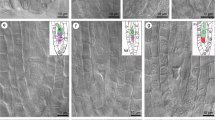Abstract
In cultures of Alaria crassifolia Kjellman, unfertilized eggs developed normally into haploid sporophytes which differentiated into a holdfast, stipe and blade with a midrib. The terminal cells of a male gametophyte grew apogamously into haploid sporophytes with narrow blades which lack the midrib. Further, diploid gametophytes were formed by apospory from vegetative cells of a diploid sporophyte. They were monoecious and their fertilized eggs developed into tetraploid sporophytes. Nuclear phases of the sporophytes and gametophytes concerned were confirmed by cytological observations.
Similar content being viewed by others
Literature Cited
Kemp, L. and K. Cole: Chromosomal alternation of generations in Nereocystis luetkeana (Mertens) Postels and Ruprecht. Can. J. Bot. 39, 1711–1724 (1961).
Kornmann, P.: Über die Entwicklung einer Ectocarpus confervoides-Form. Pubbl. Staz. zool. Napoli 28, 32–43 (1956).
Müller, D. G.: Diploide, heterozygote Gametophyten bei der Braunalge Ectocarpus siliculosus. Naturwissenschaften 7, 357–358 (1970).
Saito, Y.: An ecological study of Undaria pinnatifida Sur. II. On the influence of environmental factors upon maturity of gametophytes and early development of sporophytes. Bull. Jap. Soc. scient. Fish. 22, 235–239 (1956).
Sauvageau, C.: Sur la sexualité heterogamique d'une laminaire (Saccorhiza bulbosa). C. r. hebd. Séanc. Acad. Sci., Paris 161, 769–799 (1915).
—: Sur l'alternance des générations chez le Carpomitra Cabrerae Kütz. Bull. Stn biol. Arcachon. 23, 141–192 (1926).
—: Sur quelques algues pheosporées de la rade de Villefrance (Alpes-Maritimes). Bull. Stn biol. Areachon. 26, 254–420 (1931).
Schreiber, E.: Untersuchungen über Parthenogenesis, Geschlechtsbestimmung und Bastardierungsvermögen bei Laminarien. Planta 12, 331–353 (1930).
Segi, T. and W. Kida: Studies on the development of Undaria undarioides (Yendo) Okamura. I. On the development of the gametophytes and influence of light intensity on it. Rep. Fac. Fish. prefect. Univ. Mie. 2, 517–526 (1957).
Tatewaki, M.: Formation of a crustaceous sporophyte with unilocular sporangia in Scytosiphon lomentaria. Phycologia 6, 62–66 (1966).
Ueda, S.: On the temperature in relation to the development of the gametophyte of Laminaria religiosa Miyabe. J. imp. Fish. Inst., Tokyo 24, 138–139 (1929).
Yabu, H.: Nuclear division in the sporangium of Alaria crassifolia Kjellm. Bull. Fac. Fish. Hokkaido Univ. 8, 185–189 (1957).
—: Early development on several species of laminariales in Hokkaido. Mem. Fac. Fish. Hokkaido Univ. 12, 1–72 (1964).
— and J. Tokida: Application of aceto-ironhaematoxylinchloral hydrate method to chromosome staining in marine algae. Bot. Mag., Tokyo 79 (938), 381 (1966).
Author information
Authors and Affiliations
Additional information
Communicated by M. Anraku, Nagasaki
This work was supported by Grant No. 38803 from the Ministry of Education of Japan.
Rights and permissions
About this article
Cite this article
Nakahara, H., Nakamura, Y. Parthenogenesis, apogamy and apospory in Alaria crassifolia (Laminariales). Marine Biology 18, 327–332 (1973). https://doi.org/10.1007/BF00347797
Accepted:
Issue Date:
DOI: https://doi.org/10.1007/BF00347797




